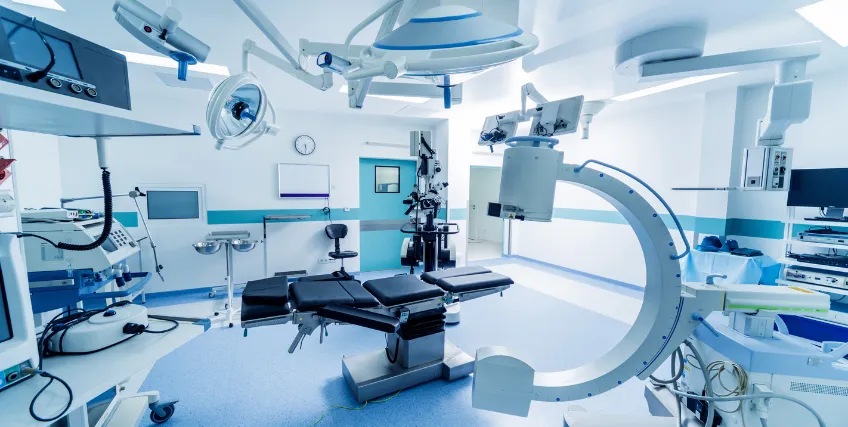A Prescription for Physicians Needing Small Business Loans
March 1, 2025 | Last Updated on: March 1, 2025

Startup costs for medical offices can be significant. Any physician who has purchased or rented a building and renovated it can tell you how costly it is to set up a new office. And that’s before purchasing medical equipment, computers and software, phone systems, furniture, supplies, and hiring staff.
Complicating matters is that doctors aren’t automatically wealthy. In fact, for the first few years, they may struggle financially. According to the Education Data Initiative, 73% of medical students graduate with debt, and the average medical school debt is $234,597. Even with a well-paying career on the way, it can take years to grow a medical practice and reduce that debt.
Most physicians starting a private practice will struggle to do so with personal assets. As such, the best business loans can be a huge asset.
In this article:
- Discover why physician practice loans are important and how you can use them.
- Explore the best business loans for physicians.
- Learn how to get a physician practice loan for your practice.
Why Physician Practice Loans Are Important
Physicians can often feel a financial crunch. Malpractice insurance, new medical equipment, and hiring a staff is all very expensive. Not to mention the cost of rent, medical supplies, and other significant startup costs.
Established practices may also face the cost of digitizing records. Converting paper records into digital files is both costly and time-consuming but it is becoming more of a necessity than a luxury today.
Meanwhile, insurance companies are notoriously slow in paying and often argue over the amounts doctors can charge for certain procedures. Physicians typically don’t want to be involved in haggling for money and have to invest in hiring and training staff to deal with the complicated insurance payment process. Fewer and fewer patients are able to fully pay their medical bills on their own, which hurts the cash flow of medical practices.
How Physicians Can Use Business Loans
Just as in any profession, doctors can take medical practice loans to support business needs. Some of the most common uses of loans for doctors include:
- Hiring: Medical offices need nurses, receptionists, and other healthcare professionals, all of which are easier to hire when you have a physician loan.
- Expansion: Scaling medical practices by purchasing commercial real estate or renting new offices.
- Equipment financing: Upgrading or purchasing medical equipment.
- Technology: Financing software and other tech improvements to improve record-keeping, scheduling, and more.
- Emergency funding: Obtaining working capital and increased cash flow due to delayed payments from insurance companies, Medicare or Medicaid, and patients.
expand their locations, upgrade or purchase medical equipment or software, obtain working capital, and deal with cash flow issues due to slow insurance payments.
The best business loans offer valuable financing solutions that can help doctors focus on treating patients rather than worrying about operational expenses.
How to Get a Medical Practice Loan
Medical practices have an advantage in securing capital because lenders do not consider the industry to be as risky as, say, construction or the restaurant business. There is always a demand for medical professionals, particularly as the Baby Boom population ages.
Nonetheless, it’s always important to explore both traditional lenders and online lenders to find the best financing options available.
Getting a medical practice loan is just like applying for other types of financing. Before you begin the application process, a medical practice should write a business plan that provides a roadmap to profitability. It must include a detailed executive summary, which may be the only part of the document that an underwriter chooses to read. Additionally, the plan should outline:
- Business Description
- Local Market and Competitive Landscape
- Explanation of the Differentiator for the medical group (price, level of service, superior technology, etc.)
- Marketing Plan
- Management Team
- Financial Data, including how much the partners in the practice will also invest.
- Appendices
Once your business plan is ready, you must shop for the best loan option, just like any other small business borrower. Use the internet to compare interest rates, loan programs, and repayment schedules. Once you find a suitable lender, complete all the required forms and provide the financial documents needed (tax returns, P&L statements, etc.) to complete the loan application process.
Best Business Loans for Physicians
Medical practitioners like GPs, optometrists, dentists, and all kinds of other healthcare providers can benefit from medical practice financing. There are many funding options available, each subject to the borrower’s creditworthiness and ability to meet eligibility requirements.
Generally speaking, traditional bank loans have stricter requirements than online lenders, but both view medical practices as relatively safe industries. The business financing options we lay out below can help both new and established healthcare practices thrive.
Term Loans
Term loans are the classic form of small business lending. A lender gives a business a lump sum of cash to be repaid, plus interest, with certain repayment terms. These loans are subject to credit approval and interest rates may vary significantly between short-term loans and long-term ones.
Traditional banks typically have stricter minimum credit score requirements than online lenders, as well as longer underwriting periods. With traditional loans, you’ll pay monthly payments throughout the term of the loan until you’ve repaid the full loan principal, plus interest.
The best business loans offer low interest rates, reasonable repayment terms, no prepayment penalties, and no restrictions on how you spend the money. As such, they can operate as equipment loans, finance new office space or renovations, support marketing for an existing practice, and more.
If things change with your business, you can often refinance into a better rate for a refinancing fee.
SBA Loans
Physicians with credit scores above 640 will likely qualify for SBA Loans, which are backed by the U.S. Small Business Administration. The SBA 7(a) loan program is the most popular, offering comparatively low interest rates and loan amounts up to $5 million. Lenders like the government guarantees on the loans. In the case that the borrower defaults, the SBA will cover a significant portion of the cost, minimizing risk for the lending institutions.
The approval process for SBA loans will be a bit more time-consuming than a line of credit or even a traditional small business loan from a bank. Startup costs can be significant for doctors who are starting a new practice independently or with a partner. Land purchases, building renovations, medical equipment purchases, and record digitization are major expenditures that can be covered by SBA loans.
Business Line of Credit
Doctors usually easily qualify for business lines of credit, flexible, short-term funding solutions that are a cross between a loan and a business credit card. Lines of credit can be used for all types of expenses, including equipment purchases and the cost of purchasing an office building.
With a line of credit, you’ll have access to a maximum loan amount, but instead of paying interest on that amount, you only pay for what you use. So, when you debit the credit line, you get a deposit to your bank account. Then, when you pay back that amount, plus the interest rate within the repayment schedule, you’ll regain access to the full loan amount.
Since it’s a flexible funding solution, a business line of credit is an excellent loan for doctors who need help increasing cash flow and working capital while awaiting payments. It’s one of the best business loans for building a practice, too, since you can always access money when you need it for unforeseen expenses.
Conclusion
Even successful healthcare groups can use cash infusions. Physician practice loans help both new and established medical practices finance expansion, navigate cash flow crunches, improve technology, and much more. Just like small businesses, loans for doctors are excellent resources and there are many loan programs available to support your business.
FAQs
What’s the difference between a medical office and a small business?
A healthcare practice is a type of small business. They rely on making a profit to stay in business.
How can you get a physician practice loan?
Getting a physician practice loan is just like getting any other type of small business loan. You should prepare a business plan, determine how much funding you need, and shop both traditional lenders and online lenders to find the best interest rates and terms available. When you’re ready, you can usually apply online.
Are medical loans and small business loans different?
Some lenders may offer medical-specific loans, but generally speaking, medical practice loans are not different from other small business loans.
What are the best business loans for medical practices?
There are many loan options for your medical practice. Depending on your practice’s goals, you may pursue term loans, commercial real estate loans, medical equipment financing, or more flexible working capital solutions like a business line of credit.
How can medical practices use loans?
Medical practices can use loans for a wide variety of business purposes, from real estate or equipment leasing to payroll and hiring, buying medical supplies, investing in marketing campaigns, and more.




